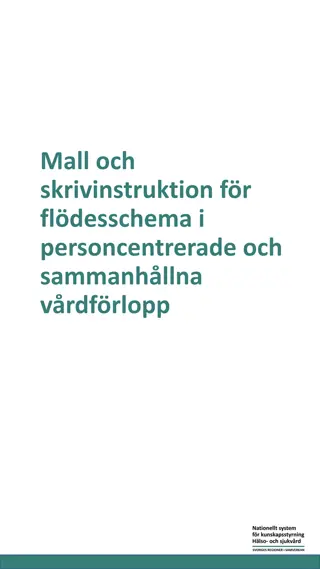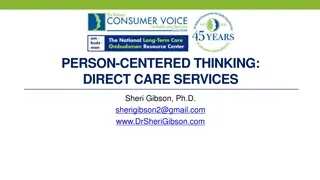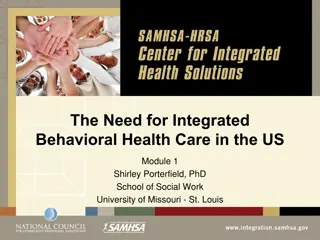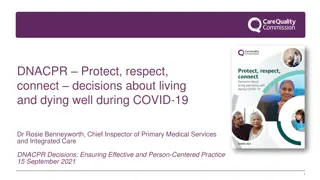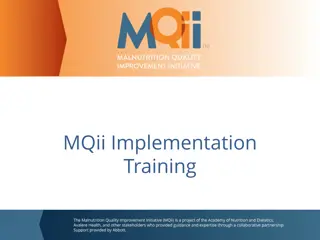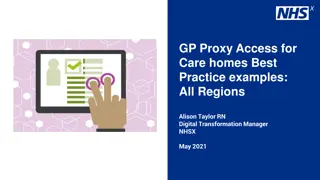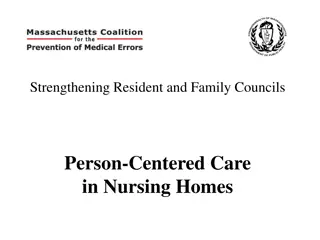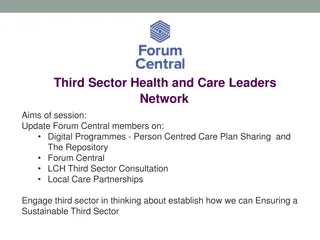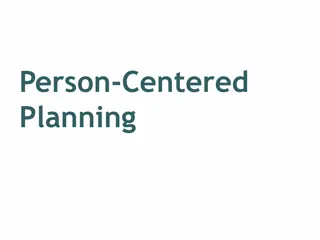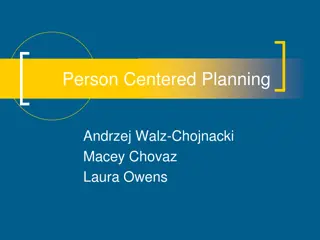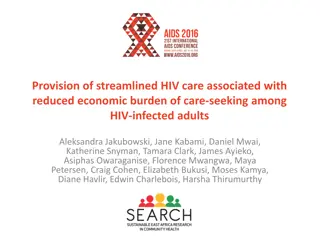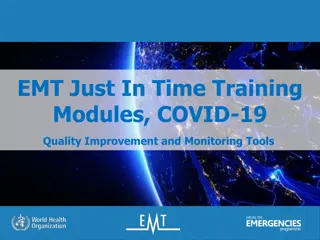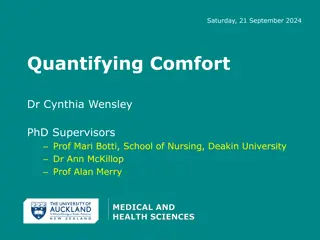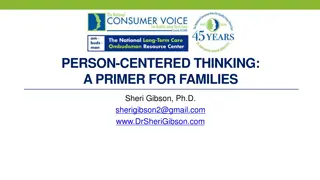Understanding Person-Centered Care in Healthcare Research
Explore the concepts of person-centered care in healthcare research, focusing on key differences from problem-oriented care, emerging research questions, methodological considerations, and implications for study populations, interventions, and outcomes. Learn about the definition of patient-centered care, distinctions between patient-centered and person-focused care, and the importance of respecting individual patient preferences and values in guiding clinical decisions.
Download Presentation

Please find below an Image/Link to download the presentation.
The content on the website is provided AS IS for your information and personal use only. It may not be sold, licensed, or shared on other websites without obtaining consent from the author. Download presentation by click this link. If you encounter any issues during the download, it is possible that the publisher has removed the file from their server.
E N D
Presentation Transcript
Person- (and Practice-) Centered Research James W. Mold, MD, MPH Emeritus Professor of Family and Preventive Medicine University of Oklahoma
Objectives After participating in this forum, you will be able to... Explain key differences between person-centered care and problem-oriented care Identify some of the information needs and research questions raised by person-centered care Discuss the implications of person-centered care for research methods (study populations, interventions, and outcomes) Explain how the same principles can be applied to research and QI initiatives with practices.
Disclosures No conflicts of interest Work History: 1977-1978: 6 months as a general physician in Ghana, W. Africa 1978-1984: Private family practice, Hillsborough, NC 1984-1988: Univ. of OK, Fam. Med. Undergrad, Med. Educ. 1988-1993: Univ. of OK, Fam. Med. Geriatrics 1993-1994: Univ. of Louisville, Fam. Med. Geriatrics 1994-2014: Univ. of OK, Fam. Med. Practice-Based Research 2014-present: Retired, independent contractor Univ. of OK, and UNC
Outline Features that distinguish (true) person-centered care from problem-oriented care (20 min. + 10 min. discussion) New research questions raised by person-centered care (20 min. + 10 min. discussion) Methodologic issues raised by person-centered care (20 min. + 10 min. discussion) Please interrupt at any time if you are confused or have a clarifying question.
PART ONE Person-Centered Care
Definition of Patient-Centered Care Providing care that is respectful of, and responsive to, individual patient preferences, needs, and values, and ensuring that patient values guide all clinical decisions. (National Academy of Medicine, 2015) Very broad, encompassing several different typologies*: Whole person, problem-oriented care (biopsychosocial model) Holistic care (whole patient rather than parts of patient) Shared decision-making (EBM, value-based purchasing, PCORI) Collaborative care (rather than paternalistic care) System improvements (care coordination, navigators, PCMH, ACOs) Guided care (rather than having to navigate a complex, fragmented system) Person-centered care (narrative medicine, relationship-based care, goal- directed care) Promoting the fulfillment of the person s life project *Tanenbaum SJ. What is patient-centered care? A typology of models and missions. Health Care Anal (2015) 23:272-287.
Patient-Centered vs. Person-Centered Starfield B. Is patient-centered care different from person-focused care? Perm J, 2011; 15(2): 63-69. Both patient-centered and person-focused care are important, but they are different. In contrast to patient-centered care (at least as described in the current literature with assessments that are visit-based), person- focused care is based on accumulated knowledge of people, which provides the basis for better recognition of health problems and needs over time and facilitates appropriate care for these needs in the context of other needs. That is, it specifically focuses on the whole person. Proposed enhancements and innovations to primary care do not appear to address person-focused care. Eklund JH, et al. Same same or different? A review of reviews of person-centered and patient-centered care. Patient Educ. Counselling. 2019; 102(1): 3-11. The analysis revealed that the goal of person-centered care is a meaningful life while the goal of patient-centered care is a functional life.
Forces Driving Implementation of Person- Centered Care Rising cost of health care (rationing vs. prioritization) Continued increase in fragmentation of care through carve-outs Palliative care, multi-problem patients, seriously ill patients, athletes, the elderly, women Patients desire for greater involvement in decision-making Increasing importance of prevention Increased awareness of the behavioral, social, and environmental determinants of health Increasing need for interdisciplinary teamwork Physician frustration with corporatization/industrialization of medicine; reduced joy in practice; burnout Genetic testing and genomic medicine
Primary Care Defined by processes (access, coordination, continuity, comprehensiveness, partnership with patients, etc.) not pathology Cradle to grave (lifespan orientation) Relationship-based Whole person within family and social context In sickness and health (normal life events, health promotion, prevention) Goal-directed (meaningful outcomes) The mission of primary care is to help each person experience a full, meaningful, and rewarding life (i.e., person-centered care). Because of the circumstances of our evolution, we never developed and implemented a conceptual model compatible with that mission.
A man walks into a bar with a frog on his head, and the bartender asks him, Where did you get that? The frog answers, I m not sure. It started as a tiny pimple on my butt.
Care Plan Structures Person-Centered Care Problem-Oriented Care* Problems Goals Prevent premature death Obstacles High CAD Risk; HTN; High LDL Plan Aerobic activities; SMART Diet; ramipril; statin trial; colonoscopy Comprehensive home exercise program; PT Update directives; review with kids; update Will; unload junk Goals Plan HTN BP<140/90 ACEI, etc. Hyperlipidemia LDL<100 Diet; statin Rotator Cuff Tendonitis Resolve tendonitis Ortho, PT, etc. Allergic rhinitis Control Zyrtec Play basketball Tendonitis, Statin concerns Advance directives out of date; Children out of country symptoms HPDP Complete services Colonoscopy Minimize end-of-life burden on family *Assumes that correcting problems will result in longer, better life, so no need to explore goals.
Personal Health Goals There are four personal goals to which primary care clinicians knowledge and skills often apply: Prevention of premature death and/or disability Maintenance and/or improvement in quality of life (includes activities, relationships, meaning/purpose, etc.) Optimization of person growth and development Increasing the probability of a good death
Adrian Metcalf 12 y.o. AA boy being raised by single mother; below median household income; urban, high-crime neighborhood; loaded, unlocked gun in house; rides bike without helmet; unhealthy diet; BMI 65%tile; little physical activity; fam. hx of HTN, CVA, DM; UTD on immunizations. Goal: Prevent premature death: Estimated life expectancy: 67 Could gain 4.2 additional years of life by:* Increasing physical activity (2.5 years) Firearm safety measures (1.2 years) Eating a healthier diet (0.5 years) Note: I was not able to accurately estimate impact of moving to safer neighborhood. The estimated impacts of other preventive strategies are negligible. *Calculated using a predictive model developed by Zsolt Nagykaldi Nagykaldi Z, et al. Applied Clin Informatics 2013; 4(1): 75-87.
Jeremy Scott 33-y.o. with chronic shoulder pain from an HS sports-related rotator cuff tear. Has seen a primary care doctor, an orthopedic surgeon, and a physical therapist. Tried rest, heat, and ice, a variety of exercises, an injection, anti-inflammatory medications. Was offered surgery but with difficult recovery and no guarantees. Goal: Improve QOL (ability to participate in meaningful activities): When asked what he would like to be able to do that he couldn t because of the shoulder problem, he said he would like to be able to go bow hunting with his brothers. It then occurred to him that he might be able to use a crossbow with a physician s note. Note written
Mary and Sarah Treadwell 40-y.o. F and her 70-year-old mother, a long-time patient. Since the death of father when 14, daughter had lived with mother. When tried to become more independent get a job, go on dates, etc. mother s symptoms (headaches, dizziness, stomach pain, fatigue) became worse. Once I began seeing the daughter, the nature of the dance became clear. Goal: Enhance personal growth and development: Some time at each visit spent teaching/encouraging each of them to contribute to the other s psychological growth. Focusing on personal development as a goal helped the daughter find the courage to get a job, move out, and get married (the identity and intimacy tasks) and the mother to proudly let her do so (the generativity and ego identity tasks).
Mrs. Lively 75-y.o. widow. Daughter brought her in with concerns about short-term memory loss, a concern shared by her mother. Cognitive testing confirmed; judgement and decision-making abilities still intact. Goal: Increase the probability of a good death: Discussed probability that her thinking difficulties might get worse over time, and asked her if there would be a point at which she would no longer want to her life to be prolonged. She said if she was no longer able to recognize family members. Two years from that encounter, daughter called to tell me that her mother no longer recognized her. Life-prolonging medications were stopped, and she died peacefully a few weeks later.
Common Misconceptions Patients are entirely responsible for determining goals Identifying goals is difficult, time-consuming Much can be assumed Requires different set of questions Only useful with complex patients Though it is more useful in these patients Will result in errors of omission Can t happen/too many systems obstacles
Practice #103 Common practice goals?? Provide best possible care to individual patients Ensure financial viability for the practice Increase joy in practice for clinicians and staff Improve community health outcomes 2-MD peds practice enrolled in asthma QI project. Office manager, receptionist, billing clerk, and two MAs. Hispanic patient population. Stressful work environment. Goal: Increase joy in practice Facilitator interviewed MDs and staff. Office manager doing most of the work; didn t trust the other staff members to do it well. Facilitator helped staff update job descriptions, training schedules, and metrics. Office manger began allowing staff to do their jobs. Everyone s spirits improved.
Discussion Questions What questions to you have about Tanenbaum s typology of patient- centered care? Does person-centered care exist in nature? What concerns do you have about goal-oriented care as a model of person-centered care? What additional information and skills would you need before you would try to implement person-centered health care in your setting? In your experience, what are the most common goals of clinicians/practices? What additional questions do you have about how the model might apply to dissemination/implementation research in practices? www.goaldirectedhealthcare.org www.patientprioritiescare.org https://www.narrativemedicine.org/about-narrative-medicine/ https://www.uclahealth.org/nursing/relationship-based-care
PART TWO Research Questions
Overarching Questions Does a person-centered approach to care result in better outcomes than the current problem-oriented approach? If so, which outcomes for which patients, how, and why? And what will it take to disseminate and implement it?
Literature Reviews Rathert C, et al. Patient-centered care and outcomes: A systematic review of the literature. Med Care Res Rev 2012; 70(4): 351-379 Overall, the literature on PCC processes and outcomes portrays generally positive empirical relationships between PCC and intermediate as well as some distal outcomes. Although the randomized studies found mixed results for long-term clinical outcomes, some of these studies did find positive relationships. Almost all studies, regardless of methodology, found positive relationships between PCC processes and patient satisfaction and well-being. Surprisingly, none of the PCC studies in this review examined involvement of family.
Recent Literature Reviews Kogan AC, et al. Person-centered care for older adults with chronic conditions and functional impairments: A systematic literature review. JAGS 2016; 64: c1-c7. Fifteen descriptions of PCC were identified, addressing 17 central principles or values. The six most-prominent domains of PCC were holistic or whole-person care, respect and value, choice, dignity, self-determination, and purposeful living. Although multiple definitions and elements of PCC abound with many commonalities and some overlap the field would benefit from a consensus definition and list of essential elements to clarify how to operationalize a PCC approach to health care and services for older adults.
Recent Literature Reviews Delaney LJ. Patient-centered care as an approach to improving health care in Australia. Collegian 2018; 25(1): 119-123. Higher rates of adherence; self-management; goal achievement Greater patient satisfaction Reduced need for dx testing, subspecialty care, hospitalization Higher likelihood of end-of-life preferences being followed More accurate clinical information; better patient-clinician communication Improved patient safety However, most studies cited were conducted in hospitals and long-term care settings.
How to Keep Prevention on the Table in the Face of Disease Management Incentives When disease management is used to prevent premature death and disability, it is prevention. In person-centered care, diseases are viewed as risk factors for premature death and disability. A person-centered approach eliminates the conflict. New questions raised by this re-conceptualization include: Do we need to reconceptualize continuous risk factors (next slide), and does that require a new terminology? How can we analyze increasingly complex risk/resiliency profiles in order to prioritize preventive strategies? How can we track progress (life extension) over time in a way that is meaningful for patients and clinicians?
Impact of BP Reduction on Risk of CVA and MI Chart Title 35% 30% Hypertension Normotension 25% 20% % Risk 15% 10% 5% 0% 200 180 150 140 120 Systolic BP CVA MI From Archimedes (David Eddy)
From the Wellness Portal/Health Planner (Zsolt Nagykaldi) //
Improving Current Quality of Life (QOL) QOL can be defined as being able to do the things that make life worth living, that produce pleasure, satisfaction, meaning, and growth. Everyone defines QOL differently. That creates challenges for researchers. We need to know: How can clinicians help patients clarify and prioritize their QOL priorities? How can we systematically elicit and consider functional requirements, obstacles, opportunities, adaptations, and alternatives in order to provide the best assistance? How can we arrive at an effective plan of care and how and when should it be reevaluated and adjusted as lessons are learned?
Supporting Personal Growth and Development G&D is an important focus of pediatric and end-of-life care but often neglected in adolescents and adults. Includes physical, psychological, and spiritual components Research questions: What is the best way to assess and track the various components of personal growth and development across the lifespan and to recognize and respond when obstacles and challenges arise? How can we help patients of all ages and their families negotiate developmental challenges? How can we help patients and families become progressively more resilient, both physically and psychologically?
Increasing the Probability of a Good Death In problem-oriented care, death tends to be viewed as failure or defeat. Neither patient nor clinician wants to think or talk about it until it is imminent. In a goal-directed approach death is viewed as an inevitable life event for which it makes sense to plan ahead. Research questions: What are the best ways to clarify in advance, document, and communicate when life prolonging measures should be stopped (e.g., conditions worse than death)? How should we identify, document, and periodically update end-of- life values and preferences? How and when should we include family members and significant others in development of end-of-life directives? How can we make sure that current advance directives are available at all points of care, activated when necessary, and followed?
Helping Practices Achieve their Goals To date, most D&I research and QI initiatives have been directed at increasing practice adherence to guidelines (problem-oriented). A practice-centric, goal-directed approach would require additional information about: What, in fact, are the most common practice goals? How can peer advisors and facilitators help practices clarify their goals, objectives, and priorities? What is the best way to arrive at a feasible plan and to adjust it based upon lessons learned during implementation? What metrics make sense for common practice goals? Should each practice develop its own metrics? When helping practices achieve their goals, how much of what kinds of help are most helpful?
Discussion Questions Did you understand what I proposed regarding viewing diseases as risk factors and how that leads to the idea of de-dichotomization? What kinds of additional/better data would we need to be able to more accurately prioritized preventive strategies? Quality of life is obviously complex. Can you envision a way to help patients define what it means for them? Do you think primary care clinicians should focus more on personal growth and development or is this mission creep? How would you design an electronic record for person-centered care? What metrics would be appropriate for measuring the quality of person-centered care?
PART THREE Research Methods Study Populations Interventions Outcomes
Overarching Research Questions Does a person-centered approach result in better outcomes than the current problem-oriented approach? If so, what is the best way to provide it? Who will benefit most? And how should we define better outcomes?
Possible Study Populations All primary care patients? Patients Who Would Probably Benefit the Most? Older patients Children Patients with multiple risk factors Patients at risk for overdiagnosis and treatment Patients with disabilities Patients whose likely cause of death is clear or near Patients who require an interdisciplinary team approach
Developing and Studying Processes Because interventions for each patient will be different, we will need to study the processes used to arrive at individual care plans. Challenges include: Processes usually include several critical steps/components. Often more than the sum of their parts (can t be deconstructed). Steps/components may have different values requirements (accuracy, efficiency, effectiveness, safety, patient satisfaction, etc.) May require an implementation strategy Relational, interactional, and psychodynamic aspects are probably key but hard to measure. Suggests direct observation or videotaping, qualitative interviews Some individualization will always be necessary. Must clarify critical vs. optional elements Individual processes affect all other processes within practices. Patients should be involved in the development and testing of processes of care.
Discovering/Developing/Studying Processes Processes are typically composed of: Principles Developing a prioritized prevention plan is sufficiently different from episodic care that the two should be separated in time/space Primary, secondary, and tertiary preventive strategies should be considered collectively when devising a prioritized prevention plan Techniques Annual wellness visits during patients month of birth Comprehensive risk assessment completed by patient and analyzed by computer using HRA tool Scripts Real age, wellness score Typical day. Good day. What would you like to see happen before you die?
Prevention of Premature Death If PCPs and patients know the potential impact of available preventive measures on their life expectancies, will they implement more impactful preventive services and achieve greater increases in estimated life expectancy? Population: Consecutive adult primary care patients Design: 1-year, cluster RCT (clinicians randomized) Intervention: Patient-completed risk assessment annually Clinician and patient receive a computer-generated list of recommended preventive measures including impact of each on ELE Wellness visit informed by results Comparison Group: Patients complete the risk assessments baseline and at 1 year; neither they nor their clinician receive the results; wellness visit. Outcome: Change in ELE after one year
Improving Health-Related Quality of Life If patients communicate their QOL priorities to their physicians, will it impact clinical decision-making and plans of care? Population: Consecutive adult primary care patients Design: clinician cross-over RCT; videotaped encounters Intervention: Patients asked to answer 3 questions about their QOL priorities on printed pre-visit questionnaire Comparison Group: Patients asked to list current symptoms on pre-visit questionnaire Outcomes (from videotaped encounters): Patient QOL concerns acknowledged/mentioned by physician (yes/no) Inclusion of QOL priorities in clinical decision-making discussion and/or plan of care (yes/no) Components of encounter based upon modified Flanders criteria
Outcomes: Prevention of Premature Death and Disability Estimated life expectancy Estimated health expectancy (disability-free years remaining) Real age Wellness score Preventive measures chosen % of all indicated % of those with highest impact (e.g., top three on relative impact list or those providing estimated 1 month of more of additional life)
Individualized QOL Instruments Patient-Specific Index (PASI) Individual QOL Interview (IQOLI) Flanagan QOL Scale (QOLS) Subjective QOL Profile (SQLP) Quality of Life Index (QLI) QOL Systemic Inventory (QLSI) Schedule for the Evaluation of Individual QOL (SEIQoL and SEIQoL-DW) Patient Generated Index (PGI) Goal Attainment Scaling (GAS)
Goal Attainment Scaling Used primarily in rehab and mental health settings. Requires assistance of a trained person Specify any number of goals/objectives prior to intervention Stipulate possible outcomes (-2, -1, 0, +1, +2) for each objective Rank the objectives in order of priority Following intervention, calculate an attainment score by summing the values of the actual outcomes, then adjust for priorities App and spreadsheets are available. Turner-Stokes L. Goal attainment scaling (GAS) in rehabilitation: A practical guide. Clin Rehab 2009; 23: 362-370
Growth and Development Body composition (weight, height, BMI, waist circumference, etc.) Strength, flexibility, balance Cardiorespiratory fitness Structural and physiological defense mechanisms Developmental milestones Psychological requirements (relationship, autonomy, competence) Health literacy; understanding of risk factors and vulnerabilities Psychological resilience Level of moral development
Good Death Discussion/documentation of conditions worse than death Discussion/documentation of end-of-life values/preferences Completion/documentation/dissemination of living Will Specification/documentation of surrogate decision-maker Completion/documentation/dissemination of DPOA Communication of end-of-life preferences to family including funeral and organ donation/autopsy/burial/cremation preferences End-of-life financial planning/arrangements (Will, etc.) Family notified regarding location of important documents, etc.
General Individualization of care plans based upon patient priorities, resources, and challenges Greater variation in management of BP, BS, etc.? Justification of recommendations based upon goals? Adherence to agreed upon plan of care Lifestyle changes Medications F/u primary care and referral appointments Referrals Rehabilitation therapists (OT, PT, ST, nutritionists, etc.) Mental health professionals Non-medical (lawyers, financial planners, ministers, etc.)
General (cont.) Perceived person-centeredness Patient Perception of Patient-Centeredness Consultation Care Measure Questions from CAHPS, PRA, PICS, CPCI, PCAS, IPC, etc. Support for psychological needs (self determination theory) Basic Psychological Need Satisfaction and Frustration Scales, etc. Neurophysiological responses Stress responses? Post-visit contemplation; idea generation Post-visit discussions with family Post-visit self-directed learning
Practice-Centered Outcome Measures Quality of Care Delivery of evidence-based care Measures of key primary care processes (access, continuity, coordination, comprehensiveness, etc.) AHRQ measures of quality (safe, effective, patient-centered, timely, efficient, and equitable) Financial Stability Revenue, revenue/time spent, overhead, profit margin Joy in Practice Various scales available (Net Promoter Score, Hackman and Oldham Job Characteristics Model to Job Satisfaction) Clinician and staff turnover Community Health Outcomes Clinician and staff engagement in community wellness initiatives ?? Preventable ED, hospitalization rates
Discussion Questions Which populations of patients would you study? What additional thoughts do you have about development and assessment of processes of care? What are some other outcome measures we should consider? How will you use the information discussed in this forum?




